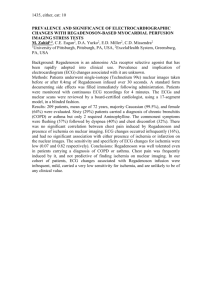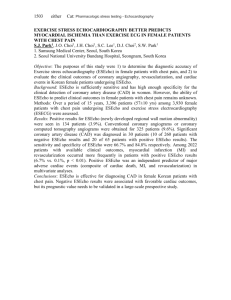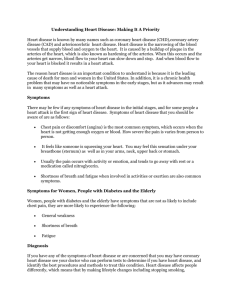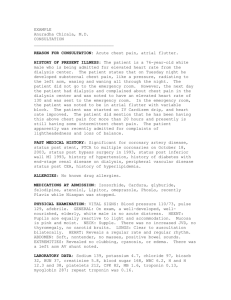KEY TO VARIABLES IN ERLANGER CHEST PAIN DATABASE
advertisement
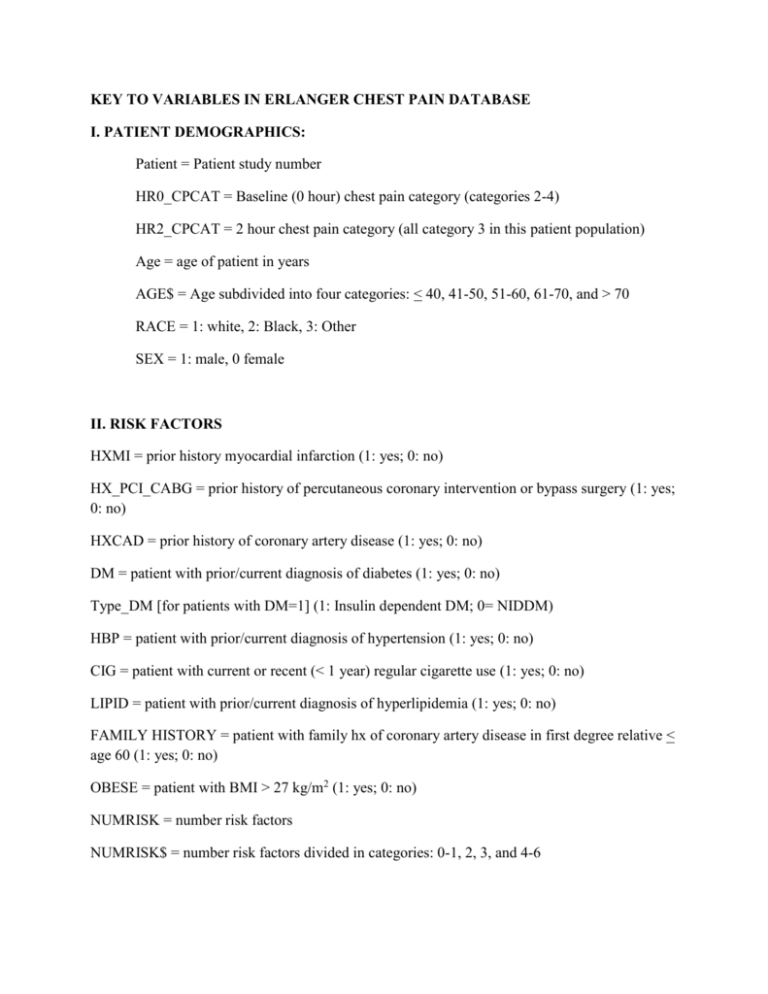
KEY TO VARIABLES IN ERLANGER CHEST PAIN DATABASE I. PATIENT DEMOGRAPHICS: Patient = Patient study number HR0_CPCAT = Baseline (0 hour) chest pain category (categories 2-4) HR2_CPCAT = 2 hour chest pain category (all category 3 in this patient population) Age = age of patient in years AGE$ = Age subdivided into four categories: < 40, 41-50, 51-60, 61-70, and > 70 RACE = 1: white, 2: Black, 3: Other SEX = 1: male, 0 female II. RISK FACTORS HXMI = prior history myocardial infarction (1: yes; 0: no) HX_PCI_CABG = prior history of percutaneous coronary intervention or bypass surgery (1: yes; 0: no) HXCAD = prior history of coronary artery disease (1: yes; 0: no) DM = patient with prior/current diagnosis of diabetes (1: yes; 0: no) Type_DM [for patients with DM=1] (1: Insulin dependent DM; 0= NIDDM) HBP = patient with prior/current diagnosis of hypertension (1: yes; 0: no) CIG = patient with current or recent (< 1 year) regular cigarette use (1: yes; 0: no) LIPID = patient with prior/current diagnosis of hyperlipidemia (1: yes; 0: no) FAMILY HISTORY = patient with family hx of coronary artery disease in first degree relative < age 60 (1: yes; 0: no) OBESE = patient with BMI > 27 kg/m2 (1: yes; 0: no) NUMRISK = number risk factors NUMRISK$ = number risk factors divided in categories: 0-1, 2, 3, and 4-6 III. OUTCOME VARIABLES ESC_AMI = acute myocardial infarction as defined by updated ESC/AHA/ACC criteria (1: yes; 0: no) ESC_MI = patient with acute myocardial infarction (rising curve of cardiac markers) and patients with completed myocardial infarction (falling curve of cardiac markers); (1: yes; 0: no) [Secondary Outcome Variable] D30_CABG = Bypass surgery < 30 days of initial emergency department visit (1: yes; 0: no) D30_PCI = percutaneous coronary intervention < 30 days of initial emergency department visit (1: yes; 0: no) D30_STENOSIS = coronary arteriogram revealing stenosis > 70% not amenable for intervention < 30 days of initial emergency department visit (1: yes; 0: no) D30_LTCOP = life-threatening complication < 30 days of initial emergency department visit (1: yes; 0: no) D30DEATH = Cardiac death < 30 days of initial emergency department visit (1: yes; 0: no) D30_ACS = Acute coronary syndrome < 30 days of initial emergency department visit (i.e. AMI, MI, CABG, PCI, STENOSIS, LTCOMP, and/or DEATH); (1: yes; 0: no) [Primary Outcome Variable] IV. DIAGNOSTIC TEST RESULTS TN_0HR = baseline (time 0 hour) troponin value TN_2HR = 2 hour troponin value DELTA_TN = 2 hour delta troponin (i.e. 2 hour troponin value minus baseline value) POS_TN_0 = baseline troponin > 0.8 ng/ml (1:yes; 0:no) POS_TN_DEL = 2 hour delta troponin > +0.1 ng/ml ECG_CAT = Findings on initial ECG: 1: Injury; 2: Ischemia; 3: Infarction, BBB, or hypertrophy; 4: normal or non-diagnostic INJURY_ECG = injury on initial ECG (1: yes; 0: no) SECG_ECG = Findings on serial ECG: 1: new/evolving injury; 2: new/evolving ischemia; 3: non-diagnostic changes; 4: no changes POS_SECG = new/evolving injury or ischemia (1: yes; 0: no) STRESS_CAT = findings on nuclear stress testing: 1= reversible ischemia; 2= no reversible ischemia; 3=borderline reversible ischemia POS_STRESS = reversible ischemia on nuclear stress testing (1: yes; 0: no) V. RISK STRATIFICATION SCORES MOR_SCORE = Morise risk stratification score MOR_RISK$ = Morise score stratified into “low,” “intermediate,” and “high risk scores” MOD_MOR_S = Modified Morise score = Morise score after excluding estrogen status MOR_SYMPT = Morise chest pain score: 1= non-cardiac chest pain; 3= atypical anginal; 5= typical angina HO_SCORE = Ho risk score FRAM_SCORE = Framingham Risk Score HEART = HEART Score HEART_WT = weighted heart strain HEARTS3 = HEARTS3 Score REFERENCES FOR RISK STRATIFICATION SCORES: Morise Score: Morise AP, Haddad J, Beckner D, et al. Development and validation of a clinical score to estimate the probability of coronary artery disease in men and women presenting with suspected coronary disease. Am J Med 1997;102;:350-356. Ho score: Ho K, Miller TD, Hodge DO, et al. Use of a simple clinical score to predict prognosis of patients with normal or mildly abnormal resting electrocardiographic findings undergoing evaluation for coronary artery disease. Mayo Clin Proc 2002;77:515-521. Framingham score: Anderson KM, Wilson PWF, Odell PM, Kannel WB. An updated coronary risk profile. Circulation 1991;83:356-362. HEART, HEART weighted, and HEARTS3 score: Fesmire FM, Martin EJ, Cao Y, Heath GW. Improving risk stratification in chest pain patients: The Erlanger HEARTS3 score. Am J Emerg Med 2012 (in press).

